Travelling Via Granite Quarries in South Africa: A Visual Odyssey
Travelling Via Granite Quarries in South Africa: A Visual Odyssey
Blog Article
Introducing the Mysteries of Granite Quarrying: Where Toughness and Style Meet
The world of granite quarrying is a realm where the raw strength of nature merges with human virtuosity to produce structures that stand the examination of time with an air of sophistication. From the depths of quarries to the meticulous polishing in workshops, the procedure of transforming granite right into building marvels is an intricate dance of custom and development. As we peer right into the depths of this old craft, we begin to reveal the surprise ins and outs that form the very significance of our constructed environment.
The Beginnings of Granite Quarrying
In the record of architectural background, the beginnings of granite quarrying are shrouded in a tapestry of ancient craftsmanship and geological wonders. Going back to old Egypt and Mesopotamia, the extraction of granite from quarries marked the beginning of a journey that would at some point lead to the development of several of the globe's most legendary structures.
Granite quarrying's roots can be mapped to the proficient craftsmens that identified the rock's resilience and aesthetic appeal. Through a mix of primitive devices and large decision, these early quarry workers uncovered granite blocks that would certainly come to be the structure blocks of people.
As people progressed, so did the methods of quarrying granite. The Romans, renowned for their engineering expertise, established advanced approaches for drawing out granite to build monoliths, holy places, and roads that stood the examination of time.
The legacy of these old quarrying techniques continues to form modern style, with granite staying an icon of stamina and elegance in construction jobs around the world. (granite quarries in south africa)
Devices of the Quarrying Trade
The development of granite quarrying strategies from ancient human beings to contemporary times highlights the crucial function played by the devices of the quarrying profession in shaping the industry's methods. In old times, quarrying devices were rudimentary, commonly including chisels, hammers, and wedges made from materials like bronze or iron. These tools required significant manpower and time to extract granite blocks from quarries.

Additionally, the introduction of pneumatically-driven devices and high-powered equipment has dramatically decreased the physical labor needed in quarrying procedures, boosting employee safety and productivity. As the quarrying market remains to innovate, the devices of the profession continue to be at the center of driving progression and shaping the future of granite extraction.
Drawing Out Blocks of Granite
Making use of accuracy equipment and progressed methods, the extraction of granite blocks from quarries has become a sophisticated process in the modern-day quarrying sector. Regulated blowing up methods are then employed to damage apart the granite right into convenient sections.

Sprucing Up and Finishing Techniques
To accomplish a perfect surface on granite blocks, competent craftsmens utilize a series of meticulous sprucing up and ending up methods. After the initial removal and forming processes, the granite blocks undergo a detailed polishing phase to boost their natural beauty and resilience.
In addition to polishing, completing strategies are used to additional improve the granite's look. By very carefully picking and using these brightening and completing methods, craftsmens can transform raw granite blocks right into charming pieces that showcase both stamina and elegance.

Ecological Effect and Sustainability
With the growing emphasis on ecological consciousness in the industry, granite quarrying techniques are progressively scrutinized for their influence on all-natural resources and lasting sustainability. Furthermore, the transportation of granite from quarries to refining check these guys out facilities creates carbon discharges, further adding to environmental destruction.
To alleviate these impacts and make certain sustainability in granite quarrying, market stakeholders are adopting different measures. Implementing sophisticated technologies to minimize energy intake and water usage, recovering quarried land for ecological repair, and promoting accountable sourcing practices are some methods being employed. Moreover, certifications such as the Forest Stewardship Council (FSC) and the Management in Energy and Environmental Style (LEED) aid consumers recognize eco-friendly granite items.
Final Thought
To conclude, granite quarrying is a procedure that calls for specialized devices and strategies to click here for more extract blocks of granite and polish them to a high level of finish. While the environmental effect of quarrying can be considerable, initiatives are being made to enhance sustainability techniques in the sector. On the whole, granite quarrying is a fragile equilibrium in between harnessing the strength and elegance of this natural stone while minimizing its impact on the environment.
Report this page